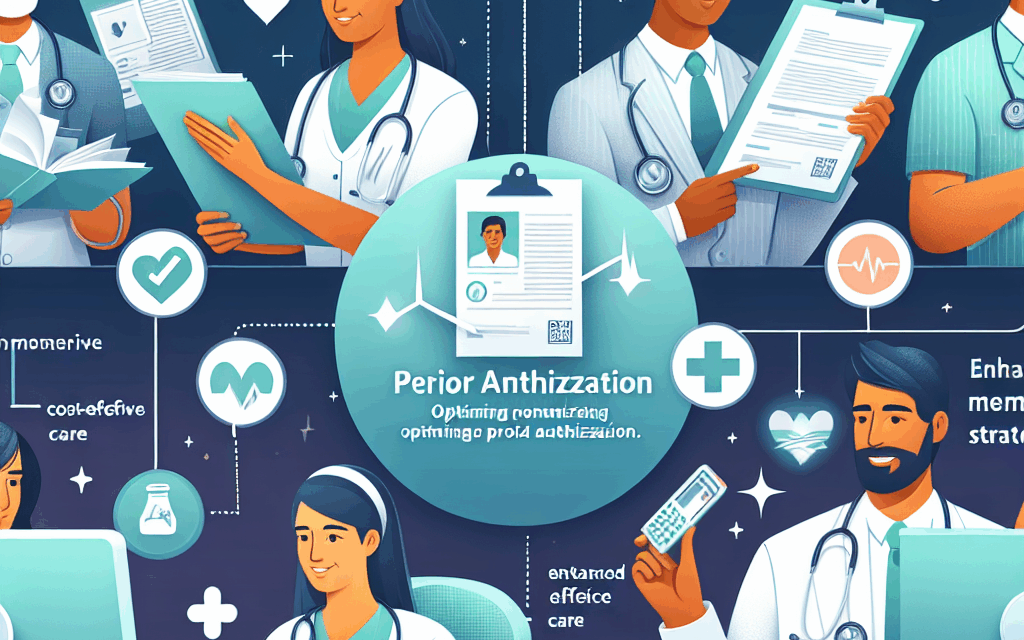Optimizing Prior Authorization: Strategies for Health Plans to Reduce Costs and Enhance Member Care
Prior authorization (PA) is a critical process in the healthcare system, designed to ensure that patients receive appropriate care while controlling costs for health plans. However, the PA process can often be cumbersome, leading to delays in treatment and increased administrative burdens. This article explores strategies that health plans can implement to optimize prior authorization, reduce costs, and enhance member care. We will delve into five key subtopics: understanding the current landscape of prior authorization, leveraging technology for efficiency, streamlining communication between stakeholders, implementing best practices for clinical criteria, and measuring success through data analytics.
Understanding the Current Landscape of Prior Authorization
The prior authorization process has become a focal point in discussions about healthcare efficiency and patient care. According to a 2021 survey by the American Medical Association (AMA), 93% of physicians reported that prior authorization delays patient care, and 78% indicated that the process has worsened over the past five years. Understanding the current landscape of prior authorization is essential for health plans aiming to optimize this process.
Prior authorization is a requirement that healthcare providers obtain approval from a health plan before delivering specific services or medications. This process is intended to ensure that the proposed treatment is medically necessary and aligns with the plan’s coverage policies. However, the complexity and variability of PA requirements across different health plans can lead to confusion and frustration among providers and patients alike.
Several factors contribute to the challenges associated with prior authorization:
- Inconsistent Requirements: Different health plans have varying criteria for what requires prior authorization, leading to confusion among providers.
- Administrative Burden: The time and resources required to navigate the PA process can detract from patient care, with providers spending an average of 20 hours per week on prior authorization tasks.
- Impact on Patient Care: Delays in obtaining prior authorization can lead to postponed treatments, exacerbating health conditions and increasing overall healthcare costs.
To address these challenges, health plans must first conduct a thorough assessment of their current prior authorization processes. This includes identifying bottlenecks, understanding the reasons for denials, and evaluating the impact of PA on patient outcomes. By gaining insights into the existing landscape, health plans can develop targeted strategies to streamline the process and improve member care.
Leveraging Technology for Efficiency
Technology plays a pivotal role in optimizing the prior authorization process. The integration of electronic health records (EHRs), artificial intelligence (AI), and automation can significantly enhance efficiency and reduce administrative burdens. Health plans can leverage these technologies in several ways:
1. Electronic Prior Authorization (ePA): The transition from paper-based to electronic prior authorization systems can streamline the submission and approval process. EHRs can be integrated with health plans’ PA systems, allowing providers to submit requests directly from their clinical workflows. This reduces the time spent on paperwork and minimizes errors associated with manual submissions.
2. AI and Machine Learning: AI can be utilized to analyze historical data and predict the likelihood of approval for specific requests. By identifying patterns in past authorizations, health plans can create algorithms that flag high-risk requests for additional review while expediting approvals for low-risk cases. This not only speeds up the process but also ensures that resources are allocated efficiently.
3. Real-Time Decision Support: Implementing real-time decision support tools within EHRs can provide providers with immediate feedback on whether a proposed treatment requires prior authorization. This proactive approach can help prevent delays by allowing providers to make informed decisions at the point of care.
4. Patient Engagement Tools: Health plans can enhance member care by providing patients with access to their prior authorization status through mobile apps or online portals. This transparency empowers patients to understand their treatment options and reduces anxiety associated with waiting for approvals.
5. Data Analytics: Utilizing data analytics can help health plans identify trends in prior authorization requests, such as common procedures that require authorization or frequent reasons for denials. By analyzing this data, health plans can refine their criteria and streamline the approval process for frequently requested services.
Case studies have shown that health plans that have adopted ePA systems have seen significant reductions in turnaround times for prior authorization requests. For instance, a large health plan reported a 50% decrease in processing times after implementing an electronic system, leading to improved patient satisfaction and reduced administrative costs.
Streamlining Communication Between Stakeholders
Effective communication among stakeholders is crucial for optimizing the prior authorization process. This includes collaboration between health plans, providers, and patients. By fostering open lines of communication, health plans can reduce misunderstandings and improve the overall efficiency of the PA process.
1. Provider Education: Health plans should invest in educational initiatives to inform providers about the prior authorization process, including the criteria for approval and common pitfalls to avoid. Regular training sessions, webinars, and resource materials can help providers navigate the process more effectively.
2. Dedicated Support Teams: Establishing dedicated support teams within health plans can provide providers with direct access to assistance when navigating the prior authorization process. These teams can help clarify requirements, address concerns, and expedite approvals when necessary.
3. Feedback Mechanisms: Implementing feedback mechanisms allows providers to share their experiences with the prior authorization process. Health plans can use this feedback to identify areas for improvement and make necessary adjustments to their policies and procedures.
4. Collaborative Care Models: Encouraging collaborative care models that involve multidisciplinary teams can enhance communication and streamline the prior authorization process. By involving various healthcare professionals in decision-making, health plans can ensure that all perspectives are considered, leading to more comprehensive care plans.
5. Patient Involvement: Engaging patients in the prior authorization process can improve transparency and reduce anxiety. Health plans can provide patients with information about what to expect during the PA process and encourage them to communicate with their providers about any concerns or questions they may have.
For example, a health plan that implemented a provider advisory council found that regular meetings with physicians led to a 30% reduction in prior authorization denials. By fostering open communication and collaboration, health plans can create a more efficient and effective prior authorization process.
Implementing Best Practices for Clinical Criteria
Establishing clear and evidence-based clinical criteria for prior authorization is essential for optimizing the process. Health plans must ensure that their criteria are aligned with current medical guidelines and best practices to avoid unnecessary delays in patient care.
1. Evidence-Based Guidelines: Health plans should base their prior authorization criteria on established clinical guidelines and evidence-based practices. This ensures that the criteria are relevant and reflect the latest advancements in medical knowledge.
2. Regular Review and Updates: The healthcare landscape is constantly evolving, and health plans must regularly review and update their prior authorization criteria to reflect new treatments, technologies, and clinical evidence. This proactive approach helps prevent outdated criteria from hindering patient care.
3. Transparency in Criteria: Health plans should make their prior authorization criteria easily accessible to providers and patients. Clear communication about what is required for approval can reduce confusion and streamline the process.
4. Utilization Management Programs: Implementing utilization management programs can help health plans monitor the appropriateness of care and ensure that prior authorization criteria are being applied consistently. These programs can identify trends in requests and denials, allowing for targeted interventions.
5. Collaboration with Clinical Experts: Engaging clinical experts in the development and review of prior authorization criteria can enhance the relevance and accuracy of the guidelines. Health plans can establish advisory boards composed of specialists who can provide insights into the latest clinical practices and help refine criteria accordingly.
A case study involving a regional health plan demonstrated the impact of implementing evidence-based clinical criteria. After aligning their prior authorization requirements with national guidelines for orthopedic procedures, the health plan saw a 40% reduction in unnecessary denials and improved patient outcomes.
Measuring Success Through Data Analytics
Data analytics is a powerful tool for health plans seeking to optimize their prior authorization processes. By collecting and analyzing data related to prior authorization requests, health plans can gain valuable insights into their performance and identify areas for improvement.
1. Key Performance Indicators (KPIs): Health plans should establish KPIs to measure the effectiveness of their prior authorization processes. Common KPIs include turnaround times for approvals, denial rates, and the percentage of requests requiring additional information. Monitoring these metrics can help health plans identify trends and make data-driven decisions.
2. Patient Outcomes Analysis: Analyzing patient outcomes related to prior authorization can provide insights into the impact of the process on member care. Health plans can track metrics such as treatment delays, hospital readmission rates, and overall patient satisfaction to assess the effectiveness of their PA processes.
3. Benchmarking Against Industry Standards: Health plans should benchmark their prior authorization performance against industry standards to identify areas for improvement. By comparing their metrics to those of similar organizations, health plans can gain insights into best practices and set realistic goals for optimization.
4. Continuous Improvement Initiatives: Data analytics should be used to inform continuous improvement initiatives within health plans. By regularly reviewing performance data, health plans can identify specific areas where changes are needed and implement targeted interventions to enhance the prior authorization process.
5. Reporting and Transparency: Providing transparent reporting on prior authorization metrics to stakeholders, including providers and patients, can foster accountability and encourage collaboration. Health plans can share insights on their performance and solicit feedback to drive further improvements.
A health plan that implemented a comprehensive data analytics program reported a 25% reduction in prior authorization turnaround times within six months. By leveraging data to inform decision-making, health plans can create a more efficient and effective prior authorization process.
Conclusion
Optimizing prior authorization is essential for health plans seeking to reduce costs and enhance member care. By understanding the current landscape of PA, leveraging technology, streamlining communication, implementing best practices for clinical criteria, and measuring success through data analytics, health plans can create a more efficient and effective process.
The challenges associated with prior authorization are significant, but with targeted strategies and a commitment to continuous improvement, health plans can transform the PA process into a streamlined and patient-centered experience. As the healthcare landscape continues to evolve, prioritizing optimization in prior authorization will be crucial for ensuring that patients receive timely and appropriate care while managing costs effectively.
In summary, the key takeaways from this article include:
- Understanding the complexities of the current prior authorization landscape is essential for identifying areas for improvement.
- Leveraging technology, such as electronic prior authorization systems and AI, can enhance efficiency and reduce administrative burdens.
- Streamlining communication between stakeholders, including providers and patients, fosters collaboration and improves the overall PA process.
- Implementing evidence-based clinical criteria ensures that prior authorization requirements are relevant and aligned with best practices.
- Utilizing data analytics to measure performance and patient outcomes enables health plans to make informed decisions and drive continuous improvement.
By adopting these strategies, health plans can optimize prior authorization, ultimately leading to better patient care and more sustainable healthcare costs.





